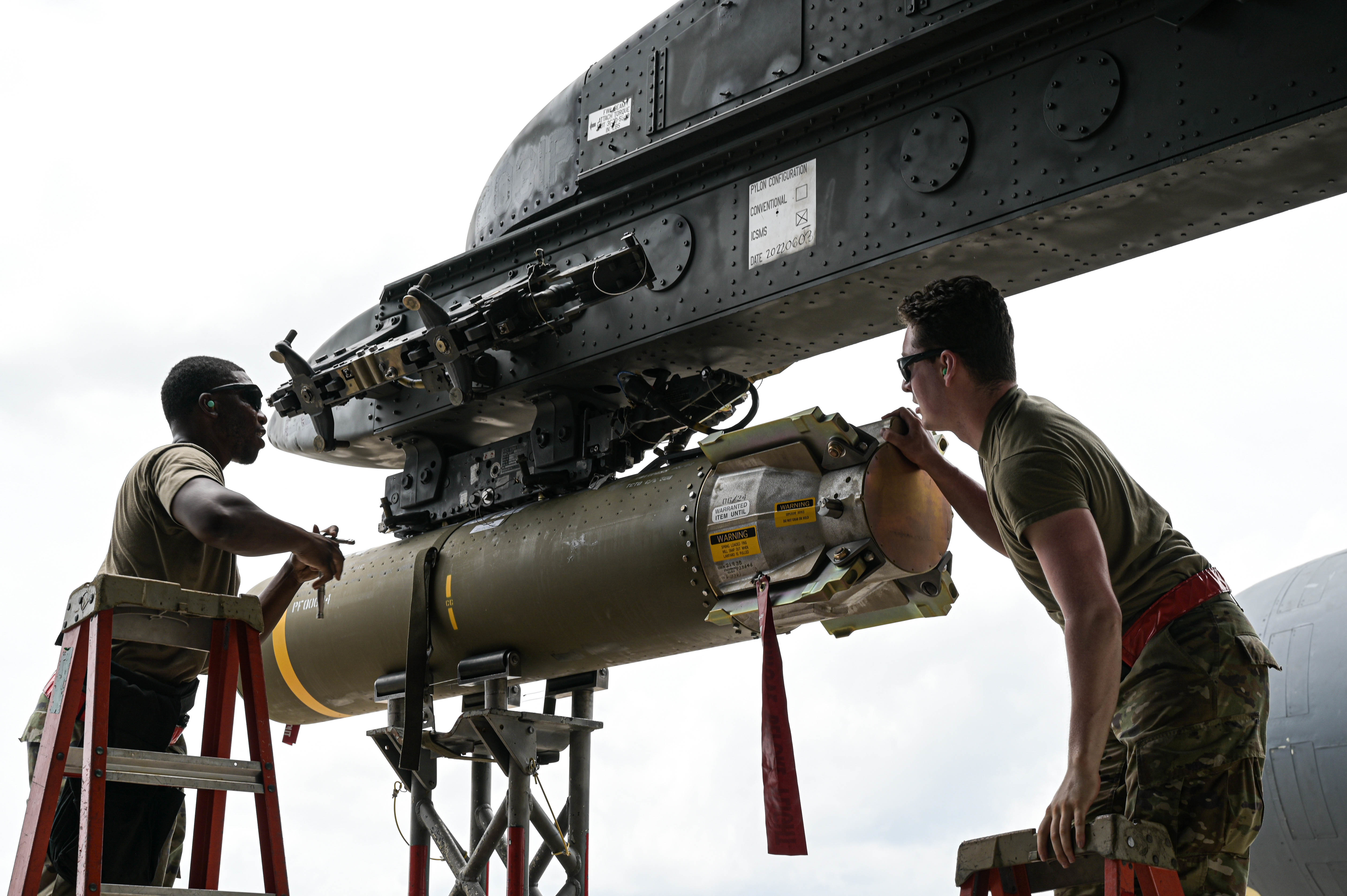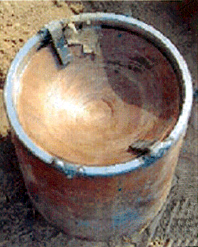|
BLU-108
The BLU-108 is an air-delivered submunition, containing four further smart "Skeet" warheads. The system is manufactured by Textron Systems Weapon & Sensor Systems since 1992. The BLU-108 is released from a munitions dispenser, with a parachute being used to slow its descent. It then fires the four rapidly rotating skeets, which use multi-mode optical sensors to identify a variety of targets ranging from tanks and missile launchers to railway locomotives and landed aircraft. When the skeet passes over what it considers a high priority target (this priority can be changed prior to employment), it fires a 0.9 kg (2 lb) explosively formed penetrator providing armor-piercing and incendiary effects, as well as a fragmentation ring meant to damage any soft targets, primarily enemy persons, in the immediate vicinity of the target. BLU-108/B specifications * Length: 78.8 cm (31.0 in) * Diameter: 13.3 cm (5.25 in) * Maximum lateral dimension: 18.4 cm (7.25 in ... [...More Info...] [...Related Items...] OR: [Wikipedia] [Google] [Baidu] |
AGM-154 Joint Standoff Weapon
The AGM-154 Joint Standoff Weapon (JSOW) is a glide bomb that resulted from a joint venture between the United States Navy and Air Force to deploy a standardized medium range precision guided weapon, especially for engagement of defended targets from outside the range of standard anti-aircraft defenses, thereby increasing aircraft survivability and minimizing friendly losses. The designation of the ''Joint Standoff Weapon'' as an "air-to-ground missile" is a misnomer, as it is an unpowered bomb with guidance avionics, similar to the older GBU-15. Development The JSOW is a fire-and-forget weapon that employs a tightly coupled GPS/INS for navigation, and is capable of day/night and adverse weather operations. The JSOW-C adds an infra-red seeker for terminal guidance. Originally the JSOW was developed by Defense Systems & Electronics division of Texas Instruments. After a first flight, funded by the company in April 1991, a joint program between the US Navy and the US Air F ... [...More Info...] [...Related Items...] OR: [Wikipedia] [Google] [Baidu] |
CBU-97 Sensor Fuzed Weapon
The CBU-97 Sensor Fuzed Weapon is a United States Air Force -class freefall Cluster Bomb Unit. It was developed and produced by Textron Defense Systems. A CBU-97 used in conjunction with the Wind Corrected Munitions Dispenser guidance tail kit is converted to a precision-guided weapon, and the combination is designated CBU-105. Overview The CBU-97 consists of an SUU-66/B tactical munition dispenser that contains 10 BLU-108 submunitions. Each submunition contains four hockey-puck-shaped sensor-fused projectiles called Skeets. These detect target vehicles, such as tanks, armored personnel carriers, trucks and other support vehicles, and fire an explosively-formed penetrator downwards at them. Operation The 40 Skeets scan an area of using infrared and laser sensors, seeking targets by pattern-matching. When a Skeet finds a target it fires an explosively-formed penetrator to destroy it. If a Skeet fails to find a target, it self-destructs above the ground; if this fails, a back ... [...More Info...] [...Related Items...] OR: [Wikipedia] [Google] [Baidu] |
Explosively Formed Penetrator
An explosively formed penetrator (EFP), also known as an explosively formed projectile (EFP), a self-forging warhead, or a self-forging fragment, is the product of a shaped charge designed to penetrate armor effectively. As the name suggests, the effect of the explosive charge is to deform a metal plate into a jet, slug or rod shape and accelerate it toward a target. They were first developed as oil well perforators by American oil companies in the 1930s, and were deployed as weapons in World War II. Difference from conventional shaped charges A shaped charge generally has a metal liner that is forced by an explosive blast into a metal jet or slug able to penetrate thick steel armor and knock out vehicles. A disadvantage of this arrangement is that the jet of metal loses effectiveness the further it travels, as it breaks up into disconnected particles that drift out of alignment. An EFP operates on the principle designed to form a distinct projectile (slug or jet), permitting ... [...More Info...] [...Related Items...] OR: [Wikipedia] [Google] [Baidu] |
Submunition
A cluster munition is a form of air-dropped or ground-launched explosive weapon that releases or ejects smaller submunitions. Commonly, this is a cluster bomb that ejects explosive bomblets that are designed to kill personnel and destroy vehicles. Other cluster munitions are designed to destroy runways or electric power transmission lines, disperse chemical or biological weapons, or to scatter land mines. Some submunition-based weapons can disperse non-munitions, such as leaflets. Because cluster bombs release many small bomblets over a wide area, they pose risks to civilians both during attacks and afterwards. Unexploded bomblets can kill or maim civilians and/or unintended targets long after a conflict has ended, and are costly to locate and remove. Cluster munitions are prohibited for those nations that ratified the Convention on Cluster Munitions, adopted in Dublin, Ireland, in May 2008. The Convention entered into force and became binding international law upon ratifyin ... [...More Info...] [...Related Items...] OR: [Wikipedia] [Google] [Baidu] |
Smart Bomb
Smart or SMART may refer to: Arts and entertainment * ''Smart'' (Hey! Say! JUMP album), 2014 * Smart (Hotels.com), former mascot of Hotels.com * ''Smart'' (Sleeper album), 1995 debut album by Sleeper * '' SMart'', a children's television series about art on CBBC Businesses and brands * S-Mart, a Mexican grocery store chain * SMART (advertising agency), an Australian company * SmartCell, a network operator in Nepal * Smart Communications, a cellular service provider in the Philippines * Smart Technologies, a company providing group collaboration tools * Smart Telecom, a network operator in the Republic of Ireland * Smart (cigarette), an Austrian brand * Smart (drink), a brand of fruit-flavored soda produced by The Coca-Cola Company for Mainland China Computing * Smart device, an electronic device connected to other devices or networks wirelessly * Self-Monitoring, Analysis, and Reporting Technology (S.M.A.R.T.), a standard used in computer storage devices * SM ... [...More Info...] [...Related Items...] OR: [Wikipedia] [Google] [Baidu] |
Textron
Textron Inc. is an American industrial conglomerate based in Providence, Rhode Island. Textron's subsidiaries include Arctic Cat, Bell Textron, Textron Aviation (which itself includes the Beechcraft, and Cessna brands), and Lycoming Engines. It was founded by Royal Little in 1923 as the Special Yarns Company. In 2020, Textron employed over 33,000 people in 25 different countries. The company ranked 265th on the 2021 ''Fortune'' 500 of the largest United States corporations by revenue. History Early history Textron started as a textile company in 1923, when 27-year-old Royal Little founded the Special Yarns Corporation in Boston, Massachusetts. The company manufactured synthetic yarns, a niche product at the time. By the start of World War II, the company was known as Atlantic Rayon Corporation and manufactured parachutes. As war production wound down, the company started making civilian products as well and was renamed Textron: “Tex" for "textiles" and "tron" ... [...More Info...] [...Related Items...] OR: [Wikipedia] [Google] [Baidu] |
Laser
A laser is a device that emits light through a process of optical amplification based on the stimulated emission of electromagnetic radiation. The word "laser" is an acronym for "light amplification by stimulated emission of radiation". The first laser was built in 1960 by Theodore H. Maiman at Hughes Research Laboratories, based on theoretical work by Charles Hard Townes and Arthur Leonard Schawlow. A laser differs from other sources of light in that it emits light which is coherence (physics), ''coherent''. Spatial coherence allows a laser to be focused to a tight spot, enabling applications such as laser cutting and Photolithography#Light sources, lithography. Spatial coherence also allows a laser beam to stay narrow over great distances (collimated light, collimation), enabling applications such as laser pointers and lidar (light detection and ranging). Lasers can also have high temporal coherence, which allows them to emit light with a very narrow frequency spectrum, spectru ... [...More Info...] [...Related Items...] OR: [Wikipedia] [Google] [Baidu] |
Infrared
Infrared (IR), sometimes called infrared light, is electromagnetic radiation (EMR) with wavelengths longer than those of visible light. It is therefore invisible to the human eye. IR is generally understood to encompass wavelengths from around 1 millimeter (300 GHz) to the nominal red edge of the visible spectrum, around 700 nanometers (430 THz). Longer IR wavelengths (30 μm-100 μm) are sometimes included as part of the terahertz radiation range. Almost all black-body radiation from objects near room temperature is at infrared wavelengths. As a form of electromagnetic radiation, IR propagates energy and momentum, exerts radiation pressure, and has properties corresponding to both those of a wave and of a particle, the photon. It was long known that fires emit invisible heat; in 1681 the pioneering experimenter Edme Mariotte showed that glass, though transparent to sunlight, obstructed radiant heat. In 1800 the astronomer Sir William Herschel ... [...More Info...] [...Related Items...] OR: [Wikipedia] [Google] [Baidu] |
Octol
{{Short description, A high explosive mixture consisting of HMX and TNT Octol is a melt- castable, high explosive mixture consisting of HMX and TNT in different weight proportions. Composition Two formulations are commonly used: * 70% HMX & 30% TNT * 75% HMX & 25% TNT Given that HMX has a much higher detonation velocity than TNT (over 2,000 metres per second faster) and forms the main part of this explosive blend, the brisance characteristics of Octol can be inferred. Applications The applications of Octol are generally military; e.g., shaped charges and warheads used in guided missiles and submunitions A cluster munition is a form of air-dropped or ground-launched explosive weapon that releases or ejects smaller submunitions. Commonly, this is a cluster bomb that ejects explosive bomblets that are designed to kill personnel and destroy vehicl .... Octol is somewhat more expensive than RDX-based explosives, such as Composition B and Cyclotol. The advantage of Octol is ... [...More Info...] [...Related Items...] OR: [Wikipedia] [Google] [Baidu] |
Fragmentation (weaponry)
Fragmentation is the process by which the casing, shot, or other components of an anti-personnel weapon, bomb, barrel bomb, land mine, IED, artillery, mortar, tank gun, or autocannon shell, rocket, missile, grenade, etc. are dispersed and/or shattered by the detonation of the explosive filler. The correct term for these pieces is "fragmentation"; "shards" or "splinters" can be used for non-preformed fragments. Preformed fragments can be of various shapes (spheres, cubes, rods, etc.) and sizes, and are normally held rigidly within some form of matrix or body until the high explosive (HE) filling is detonated. The resulting high-velocity fragments produced by either method are the main lethal mechanisms of these weapons, rather than the heat or overpressure caused by detonation, although offensive grenades are often constructed without a frag matrix. These casing pieces are often incorrectly referred to as "shrapnel", particularly by non-military media sources. History ... [...More Info...] [...Related Items...] OR: [Wikipedia] [Google] [Baidu] |
Submunitions
A cluster munition is a form of air-dropped or ground-launched explosive weapon that releases or ejects smaller submunitions. Commonly, this is a cluster bomb that ejects explosive bomblets that are designed to kill personnel and destroy vehicles. Other cluster munitions are designed to destroy runways or electric power transmission lines, disperse chemical or biological weapons, or to scatter land mines. Some submunition-based weapons can disperse non-munitions, such as leaflets. Because cluster bombs release many small bomblets over a wide area, they pose risks to civilians both during attacks and afterwards. Unexploded bomblets can kill or maim civilians and/or unintended targets long after a conflict has ended, and are costly to locate and remove. Cluster munitions are prohibited for those nations that ratified the Convention on Cluster Munitions, adopted in Dublin, Ireland, in May 2008. The Convention entered into force and became binding international law upon ratifyi ... [...More Info...] [...Related Items...] OR: [Wikipedia] [Google] [Baidu] |







